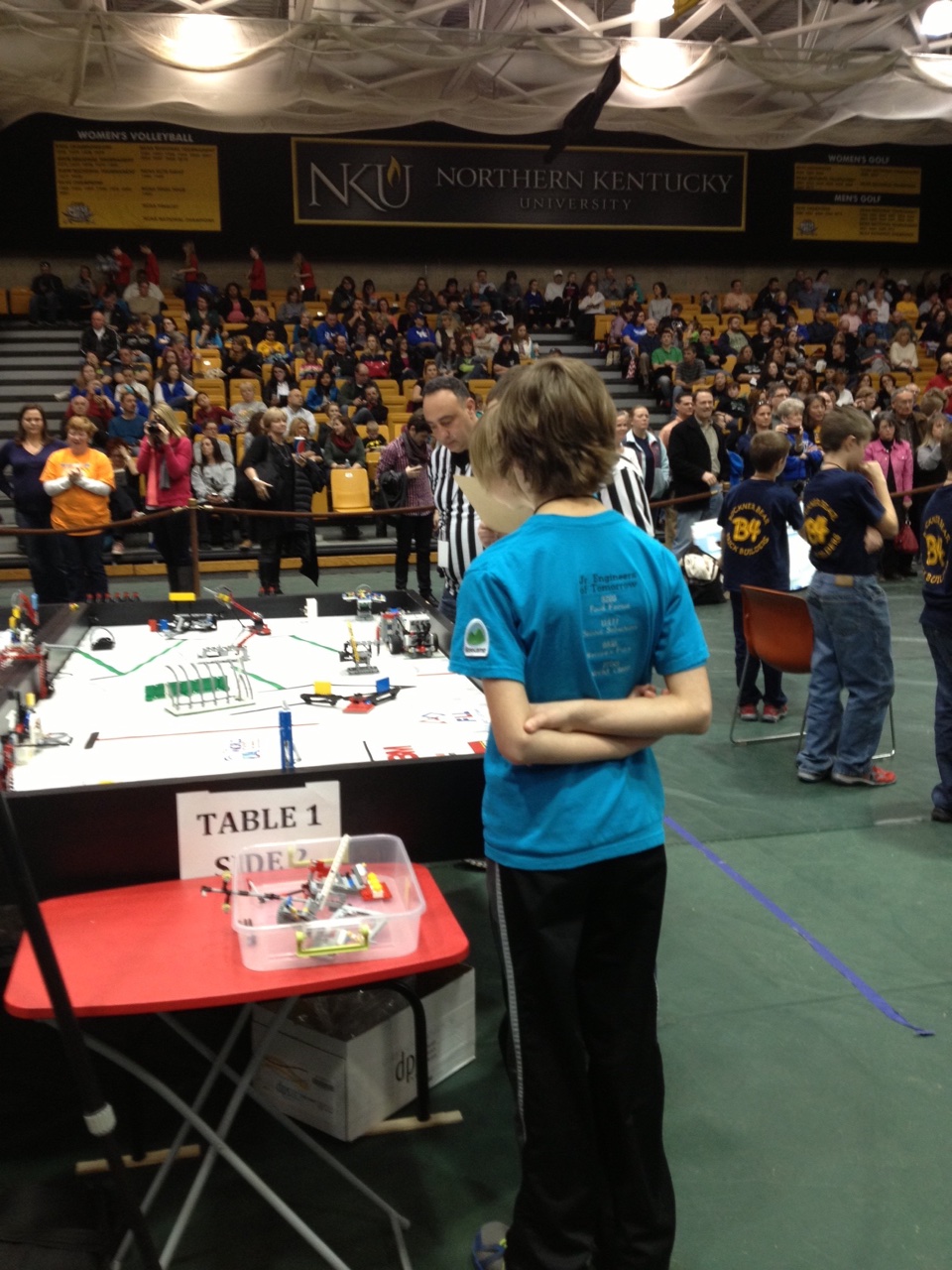I watched in disbelief as the robot crashed into the mission model. It had run the exact same mission hundreds of times during practice. We never worried about this step; it was always successful. It was “dial-tone” reliable. We had practiced on multiple tables, under different lighting conditions, trying to chase out any strange bugs that might be lurking in our assumptions.
The Jet Team member in charge of the table grabbed the robot and put it back in base; extremely frustrated. With the clock running and the parents and other teams cheering; they had little choice but to try it again. Unfortunately, the previously rock solid mission was now failing as often as it was previously succeeding. It crashed into the mission model again. Once more, they incurred a 10 point touch penalty and brought the wayward robot home. Hands quickly and deftly replaced the attachment on the robot with the one for the next mission while the other team members yelled, “Skip it! Go to the next mission!” from the sidelines. 8 seconds later, the robot trundled out of base again, leaving 125 points unclaimed forever in the past, on its way to the next mission.
After the timer expired and the buzzer sounded, the team members collected the robot attachments and we made our way off the arena floor, mingling with the 7 other teams leaving the other tables, having experienced their own trials or triumphs over the last 150 seconds. Some kids looked to me for answers, utter confusion plain on their faces. “Mr. Anderson, what happened? Why did we miss the black line?!” Others looked at their teammates, “It never missed there before, did you load the right program?”
We were at the 2014 Kentucky State FLL Tournament. 47 teams had fought their way here through various regional competitions and we were all competing for a chance to go to the FLL World Festival in St. Louis.

My mind raced back over the program they had written; I could see exactly where the program had been when it failed, but even if I knew the answer, I couldn’t tell them. Coaches don’t program in First Lego League; they shouldn’t even touch the computer or the robot. The temptation is too great to just “fix that that one thing”. So as we walked back to the pits, I fell back to my favorite activity; asking them to describe what they saw, not what they thought the robot did. Slowly, they talked each other through what happened, and the kids started to zero in on the problem.
The kids had written a line following program that would stop when the robot detected a certain reflected light intensity. It was pretty complicated, but they were very proud of it; and it worked very well. Without getting too technical, the robot measures a light intensity between zero and 100, zero being black, and 100 being white. Their program was instructing the robot to stop when it saw zero. There was no margin for error, and when the robot saw black as 1 (or more), it happily continued on its way, waiting for the magical zero measurement that would tell it to stop.
“Bump it up to five!” “Yeah, tell it to look for 5 or less!” Modifications were made, and the program tested once. We had another run coming up in 10 minutes, and had to get back to the arena. The kids looked hopeful as we walked back, confident they had fixed their issue and were going to put a respectable score on the board at last.
As the robot jerked to a stop at the beginning of the line it was supposed to follow, one of the team members looked at me. “It detected the green line as black, and stopped too early!” Resisting the urge to remind them again that the robot had no concept of “too early” and it just did what it was programmed to do, I nodded. Inside, I was ecstatic. They had seen the behavior of the robot and deduced the problem right away!
The sensor the robot uses to measure reflected light intensity uses a red LED. This leads to interesting effects when measuring the reflected light intensity of different colors. A good analog of this is the spy decoder devices that used red cellophane to reveal the hidden messages. Red shows up as white, and green is almost black. In bumping the value up to 5, they had inadvertently strayed into the “green range”.
This time, as we walked back to the pits, I didn’t have to ask anything as the team member who saw the problem explained what happened to the rest of the team. Various theories flew as to the best way to fix it, ranging from “rewrite the program” to “put it back the way it was”.
When we got back to our pit, rather than race back to the computer and start coding a fix, I had them talk through the observed behavior and the proposed solutions. Taking the ten minutes to talk about it, and analyze their options and situation proved far more valuable than spending those moments hacking at the code.
In the end, they decided they didn’t have time to rewrite the program, but they also couldn’t put it back the way it was with any confidence. Since they had bumped up to five, they decided to split the difference at two. They all agreed it was their best option under their time constraints.

The last run, due to their perseverance in tracking down this new bug and their acceptance of the time constraints they were operating under, turned out to be their best. Was it bug free? Nope. Did they get all of the points they hoped for? Nope.
Did they complete their problem mission? Yes!
Did they learn a little bit more about engineering, software development, hard deadlines, and deploying hot-fixes to production? Yes! After their last run, I had the opportunity to draw parallels between everything they had gone through during the last few hours and what we, as software engineers, do on a daily basis.
“I’m so exhausted!” exclaimed one of the team members, “I’m just mentally exhausted!”
“Congratulations on your first production deployment!”, I said. “They get better. Testing and practice are the best way to make them less exhausting, but they’re always exciting!”
In the end, we scored third place overall. No trip to the World Festival, but I got something better; I got to see the team become engineers.
